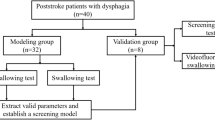Abstract
It is difficult to predict from clinical signs and symptoms which patients suffer from subglottic penetration of foods. Most investigators attempting to predict aspiration have used small numbers of patients and relatively unsophisticated statistical techniques. In this study, we utilized 249 patients to examine the predictive value of several clinical factors thought to be suggestive of subglottic penetration with discriminant analysis. Using this approach we were able to correctly predict about 2/3 of both those who aspirate and those who do not aspirate. This is better than others have reported but still inadequate for clinical purposes.
Similar content being viewed by others
References
Logemann J, Lazarus C, Jenkins P, O'Gara M: Correlation between clinical and radiographic judgements of swallowing. Paper presented at the American Speech-Language-Hearing Association annual meeting, Toronto, 1982
Splaingard M, Hutchins B, Sulton L, Chaudhuri G: Aspiration in rehabilitation patients: videofluoroscopy vs. bedside clinical assessment.Arch Phys Med Rehabil 69:637–640, 1988
Homer J, Massey W, Riski J, Lathrop D, Chase K: Aspiration following stroke: clinical correlates and outcome.Neurology 38:1359–1362, 1988
Homer J, Buoyer F, Alberts M, Helms M: Dysphagia following brainstem stroke: clinical correlates and outcome.Arch Neurol 48:1170–1173, 1991
Linden P, Siebens A: Dysphagia: predicting laryngeal penetration.Arch Phys Med Rehabil 64:281–284, 1983
Homer J, Massey W, Brazer S: Aspiration in bilateral stroke patients.Neurology 40:1686–1688, 1990
Homer J, Massey W: Silent aspiration following stroke.Neurology 38:317–319, 1988
Feinberg MJ, Ekberg O, Segall L, Tully J: Deglutition in elderly patients with dementia: findings of videofluorographic evaluation and impact on staging and management.Radiology 183:811–814, 1992
Netsell R, Daniel B: Dysarthria in adults: physiologic approach to rehabilitation.Arch Phys Med Rehabil 60:502, 1979
Palmer JB, Kuhlemeier KV, Tippett DC, Lynch C: A protocol for the videofluorographic swallowing study.Dysphagia 8:209–214, 1993
Siebens A: Rehabilitation of swallowing impairment. In: Kottke F, Lehman J (eds.):Krusen's Handbook of Physical Medicine and Rehabilitation. Philadelphia: WB Saunders, 1990, pp 765–777
Donner M: Radiologic evaluation of swallowing.Am Rev Respir Dis 131:520–523, 1985
Linden P: Videofluoroscopy in the rehabilitation of swallowing dysfunction.Dysphagia 3:189–191, 1989
Siebens A, Linden P: Dynamic imaging for swallowing re-education.Gastrointest Radiol 60:502, 1979
Author information
Authors and Affiliations
Rights and permissions
About this article
Cite this article
Linden, P., Kuhlemeier, K.V. & Patterson, C. The probability of correctly predicting subglottic penetration from clinical observations. Dysphagia 8, 170–179 (1993). https://doi.org/10.1007/BF01354535
Issue Date:
DOI: https://doi.org/10.1007/BF01354535




